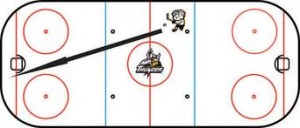Icing Hockey – What the heck is it exactly.
Now it must be obvious that our site is for pretty serious hockey fans. We discuss the game in great detail, have reporters in the dressing rooms of a bunch of NHL teams and get into some great conversations about the tactics of hockey. Still, we understand that there are a lot of brand new people to the game of hockey. Many are watching NHL games for the very first time and for a newbie some of the rules may seem a little strange. Simple hockey rules like icing and offside. We’ll start a little series here for the as-yet uninitiated. Starting with the icing rule.
The idea behind the icing rule is that flipping the puck all the way down the end of the ice then chasing after it takes away from the flow of the game. The officials needed a way to stop players from doing this. So they made a rule where you are not allowed to pass the puck to the far side of the rink, pass the red goal line from your side of the center ice line (known as the Red Line).

When icing is called by the referee the offending team is penalized. The do not get a penalty as this is a lesser evil. The sanction imposed is that the offending team has a faceoff in their own end, near their goalie. This can lead to a dangerous situation if the other team happens to win this faceoff the may get a great scoring chance.
[Related: Be sure to check out our Hockey 101 series, geared towards those just picking up the game]
The icing hockey rules have been modified somewhat a few years ago. Team always look for loopholes in the rules and what they used to do was whenever a few players got tired they would ice the puck (this would be the verb for icing) so that they could go to the bench and have another player take their spot. The new rule now states that if a team ices the puck they do not have the ability to swap out any players. Everyone must stay on the ice except in the case of injury.
Is Icing Ever Not Enforced?
There are a few tidbits about icing that are worth noting. When a team is short one player due to a penalty being served they are allowed to ice the puck without any repercussions.
At times a team will seemingly ice the puck but the official chooses to not blow his whistle. This happens when it is deemed that a defensive player could have reached the puck before it crossed the red line. This also goes to the flow of the game, the defender should play the puck when he can. This is a judgement call by the linesmen.
One other major difference with the way icing is called in the NHL as opposed to other leagues is what’s called no-touch icing. In the NHL the defender must touch the puck before an offensive player in order to validate the icing call. If the offensive player gets there first then play would continue. In many other leagues the icing call is automatic and play is blown dead as soon as the puck crosses the goal line. There is no need for the defenseman to touch the puck, hence the name ‘no-touch’ icing. Recent Modification: The rules have been altered for the 2013-14 NHL season. The race is not to the puck but to the corner face-off dots. If the defending player is ahead in the race to the dots then an icing infraction is called. This is known as hybrid icing.
One piece of hockey trivia related to icing hockey is that the WHA (big league from the seventies) never adopted the rule of allowing opposing team to ice the puck while shorthanded. Icing would still be called. The rule was introduced in 1939 and it was believed that it was a reaction to the powerhouse Montreal Candiens whose Power Play was explosive.